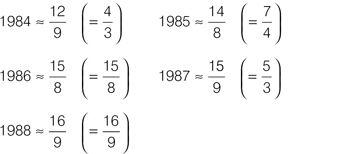How to Pass Numerical Reasoning (47 page)
Read How to Pass Numerical Reasoning Online
Authors: Heidi Smith

Projected sales to females = 96.
Section 8 Adult television viewing hours
Q1
e) Cannot tell
The table does not tell you the actual number of television-watching adults, so you cannot work out the percentage of the total females.
Q2
a) 1984
Set up the male to female ratios for each year as fractions and round the numbers to help you to reduce the fractions to the simplest form:
Some of the fractions have the same denominator, so you can easily make a comparison:

Eliminate 1987 as the higher ratio:

Eliminate 1988 as the higher ratio:

Eliminate 1986 as the higher ratio. You are left with two answer choices to compare. Compare 1984 and 1985 with a proportion:
1984 is the lower ratio of male to female viewing time.
Q3
c) 10 hours
The average female viewing time in 1984 = 8.5 and the 1983 value is 15% lower than the 1984 value. Thus the 1984 figure represents 85% of the 1983 figure (
x
):
Rearrange the formula to find
x
:

Q4
e) Cannot tell
You are not given the actual total number of adults watching television, so you cannot work out the percentage of an unknown total. Remember that to work out the actual number that a percentage represents, you need to know the total number representing 100%.
Section 9 McCoopers Consultancy New York Office
Q1
a) MBA
Set up the ratio of offers made to number of applicants then reduce the fractions to their simplest terms:

Now arrange the ratios in size order.

The smallest ratio is the MBA group.
Q2
c) Other consultancies
Recall the formula for a percentage change. Make an estimate of the two largest percentage changes and plug in the numbers:

Industry specialists % change = 50%.

Other consultancies percentage change = 75%. Therefore, the ‘Other consultancies’ category showed the largest percentage change.
Q3
b) 21
Refer to the top half of
Figure 6.3
to find the number of MBA offers in 2000 = 60 and the bottom half of the figure to obtain the percentage of MBA graduates with a preference to work in the financial services sector = 35%.

Q4
d) Academia 2000
Set up a ratio for the number of offers made to the number of applicants and reduce the ratio to its lowest terms: